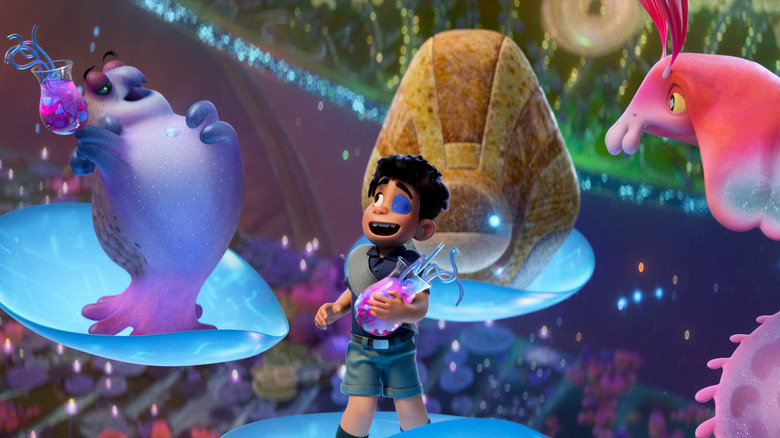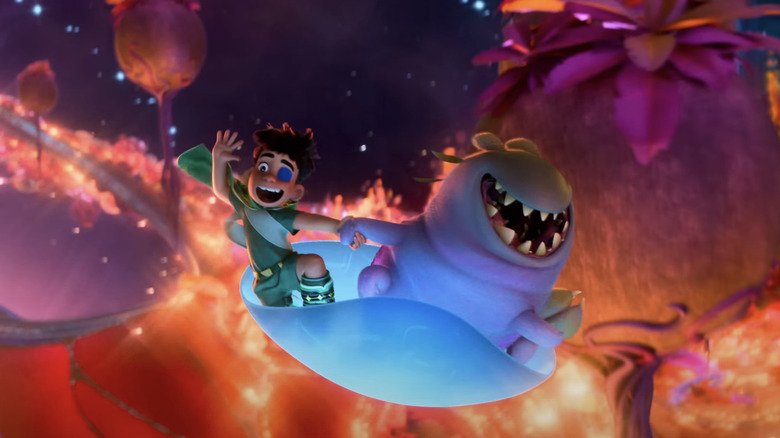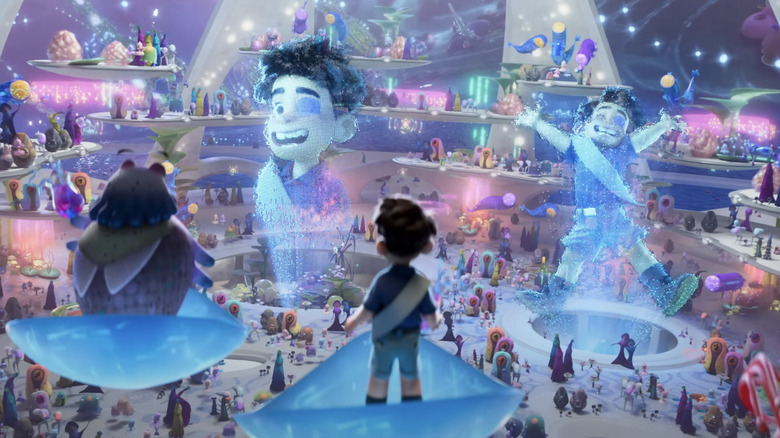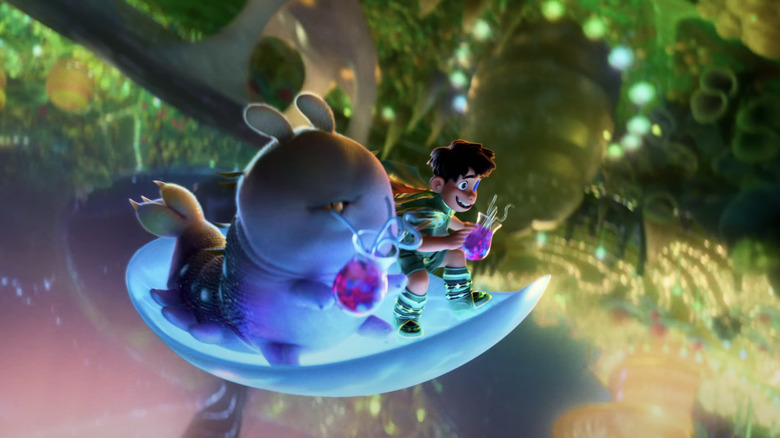How New Animation Technology Changed Pixar's Elio Production Pipeline For The Better
Pixar's "Elio" takes an 11-year-old boy, eager to be abducted by aliens, on the adventure of a lifetime when he's beamed up to the Communiverse, an otherworldly interplanetary space station filled with alien representatives from galaxies far and wide. While Pixar has taken us to space in movies like "WALL-E" and "Lightyear," audiences have never explored a world like the Communiverse before.
During an early press day at Pixar Animation campus in Emeryville, California, /Film attended a presentation featuring a selection of scenes from "Elio" totaling around 25 minutes and a guided tour behind the scenes of the animated adventure's development and production. Introducing "Elio," production designer Harley Jessup and visual effects supervisor Claudia Chung Sanii talked about creating a vibrant, exciting sci-fi world for "Elio," one unlike any they've designed and animated before. As Sanii put it:
"At Pixar, and really in our whole industry, I truly believe that what is feasible in computer graphics is limited now only by our imagination. We've done water, we've done the world of the dead, we've made characters out of water, out of fire, and, well, out of dead (and souls). What else is there to technically figure out? With 'Elio,' we could use all of our technology to create a world that is no longer Earth-bound and could satisfy our entire wish-fulfillment of space."
And they really did use all of their technology, including a new aspect that was still in the prototype stages. (Pixar has a habit of breaking new ground with its productions, as it did on "Finding Dory.") Sanii and Jessup revealed that the meticulous creation of the Communiverse itself was made possible by an animation innovation that Pixar hadn't utilized in a feature film before. In fact, this development changed the production pipeline for the entire movie.
But before we dig into the specifics, we need to explain exactly what the Communiverse is at the center of "Elio."
What is the Communiverse in Pixar's Elio?
When Elio is abducted by aliens, which he's been actively trying to accomplish by writing countless messages in the sand and sending radio messages into the sky, he ends up in the Communiverse. It consists of four parabolic rotating discs, looking like a colorful, cosmic puzzle sphere with topography and structures on either side of each disc. I'll let Harley Jessup detail exactly what they came up with when creating what he called "a unique, dazzling version of space that hasn't been seen on film before." He explained:
"The Communiverse is a colorful, interplanetary space station with the primary goal of maintaining peace and security in the universe. It has 16 member planets with embassies for the ambassadors and their delegations. Four different ecosystems are represented on the rotating discs: There's a volcanic hot disc, an icy cold disc, an aquatic disc, and a verdant, lush disc. The embassies are situated on the disc that most closely matches the climate of the delegation's home planet. The rotating discs are often shown backlit like colorful stained glass."
Each disc is beautiful in its own way, with an organic, glowing appearance of countless colors that has touches of the nighttime landscapes of Pandora in James Cameron's "Avatar," but with an even less familiar design, as structures take inspiration from microscopic organisms. And since the Communiverse is comprised of those four rotating parabolic discs where both sides are populated with buildings, aliens, and whatnot, there's always something dazzling to catch in the background, no matter which one you're focused on in the story.
However, something this beautiful comes with certain challenges. And that's where Pixar's latest innovation comes in: a toolset called Luna.
How Luna completely changed Pixar's production process for Elio
As Pixar was developing the visual style for "Elio," the team realized something about the environments they were creating for the Communiverse: A lot of what they were creating in this otherworldly space station emitted light, which created a challenge in perfecting the look of the movie without having lighting or shading completed on the film yet. Claudia Chung Sanii explained in the presentation:
"In past shows, materials, shading, and lighting actually happen at the last step of production. It's kind of odd, not like real life. This is particularly not great when everything you're building is made of luminescent and translucent materials. We needed to move lighting and shading up in our process. Fortunately, around the same time, Pixar was working on a very early prototype of a new toolset called Luna, which would bring [Pixar's 3D rendering software] Renderman to interactive workflows all across our pipeline. Lighting all the time? Yes, please!"
As Sanii puts it, "Luna allowed us to use both illumination and camera at the same time to figure out how to guide your eyes and tell a story." The result is the dazzling world that you can see in action in the latest trailer for "Elio" right here:
Harley Jessup is a veteran of visual effects who worked at Industrial Light & Magic in the 1980s and 1990s on movies like "Innerspace" and "Hook" before heading over to Pixar as production designer on movies like "Monsters, Inc." and "Ratatouille." He's about to retire with "Elio" as his last project, so he's seen plenty of innovations in both VFX and animation, but Luna is one of the standout developments in animation technology. Jessup said:
"We wouldn't see the sets or the characters lit until the very end where all these opportunities that are presented, but there wouldn't always be time to follow it through. I'm proud of those early films, but there's so much more possible because of [...] being able to see a great looking image quite a lot earlier."
Sanii explained further how the production pipeline changed thanks to Luna's assistance:
"It was enough to inspire like, 'Oh, we can do this. We can put lighting first.' So even if we weren't interactively seeing the set with full lights, which we sometimes did, actually seeing reflections was easier when we did that. We would at least render all the time with lighting. So Jordan Rempel, our lighting DP [director of photography], would get into shots right at layout time. Usually that would happen after animation because you don't want to waste time. But we did it early on our show."
Luna helped bridge the gap between art and technology on Elio, but it's still developing
Sanii felt like Luna also helped bridge a gap between art and technology that often exists on animated films. She noted:
"I think it's interesting, because traditionally there's usually a separation between art and tech, and you feel that. You're like, 'Oh, I have to go back to my computer and program it.' But I think on 'Elio,' it was the first time I experienced where we were blended together. We had technical artists doing art, and we had artists doing motion graphics and these really hard technical problems and solving that as well. So I think it's exciting time to be making films."
As for whether this is the new normal for Pixar, Luna isn't quite there yet. While making "Elio," Sanii noted that Luna was still in the "pre-alpha" prototype stage. So although it helped the production of "Elio," it may not be quite ready for primetime. But even so, Sanii said, "I think future shows will be using it even more and more."
For now, we'll just have to be mesmerized by what Luna helped Pixar accomplish when the movie hits theaters on June 25, 2025.



